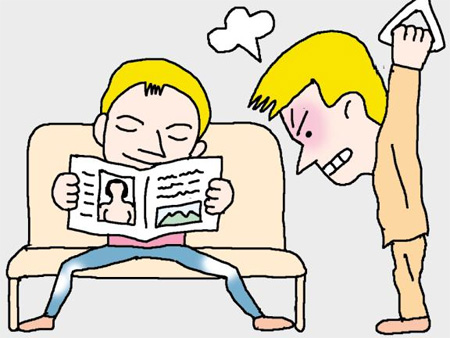좌석 버스를 탔다. 두 자리 모두 비어 있는(be unoccupied) 좌석은 없다. 누군가의 옆자리에 앉아야(sit next to somebody) 한다. 이쪽엔 ‘쩍벌남(a guy sitting with legs wide open)’이 ‘쩍’하니 앉아있다. 저쪽을 보니 한 아가씨가 옆자리에 가방이랑 목도리랑 보란 듯이 늘어놓았다. ‘딴 자리로 가라’는 무언의 압력(a silent pressure)이다.
일부 한국인들만 그러는 게 아닌가 보다. 미국 예일대 연구팀이 학술지 ‘Symbolic Interaction(상징적 상호작용)’에 발표한 조사결과에 따르면 미국인들도 마찬가지라고(the same is true of Americans) 한다.
다른 사람과 맞닿는 것을 피하기 위해 쓰는 수법(the tactics used to avoid contact with other people)은 동서고금을 막론하고(across the ages and in all countries of the world) 비슷한 모양이다.

버스에 올라탄 사람이 옆자리를 향해 오고 있다(be heading for the seat next to you). 미국인들도 인상을 쓰고(have a scowl on one’s face) 앉아 있는다고 한다. 다른 데를 선택하라고 신호를 보내는(transmit a signal to make them pick somewhere else) 것이다.
출퇴근길에 마음 편하려면(stay calm on the commuting to and from work) ‘정상적인’ 사람 옆에 앉는(sit by a ‘normal’ person) 것이 상책(a wisest thing to do)이다. ‘몹시 싫어하는 눈길’을 하고 있으면(employ the ‘hate stare’) 비켜가기 마련이다.
창가에 기대어 다리를 뻗고 앉아(lean against the window and stretch their legs out) 잠든 척한다(pretend to be asleep). 뻔뻔한 사람들은 아예 통로 쪽 자리를 잡고앉아(sit in the aisle seat) 눈을 감은 채(with their eyes closed) 헤드폰을 끼고(put in headphones) 있는다. 비어 있는 창가 자리로 들어가려는(go into the empty window seat) 사람을 못 본 척 못 들은 척(pretend neither to see nor hear) 한다.
또는 멍한 시선으로 창밖만 쳐다본다(gaze out the window with a blank stare). 휴대폰을 확인하거나 가방을 뒤지는(check phones or rummage through their bags) 척하면서 눈길을 피해버린다.
빈자리에 여러 물건을 놓아둔다(place several items on the spare seat). ‘이것들 다 치우는 걸 기다리려면 엄청 번거로운 것(a big hassle waiting for them to be moved) 아시지?’ 하는 것이다. 남에 대한 배려는 거의 없다(have little regard for the feeling of others). 마지못해(against their will) 느릿느릿 치우는 시늉을 하다 보면(go through the motions) 십중팔구(nine out of ten) 다른 자리로 가는 걸 알기 때문이다.
연구팀장은 예일대 사회학과의 Esther Chihye Kim 교수였다. 한국 이름은 김지혜. 한국에서의 ‘트라우마(trauma·정신적 외상)’가 남아있었나 보다.
☞ http://www.sciencedaily.com/releases/2012/08/120801093615.htm